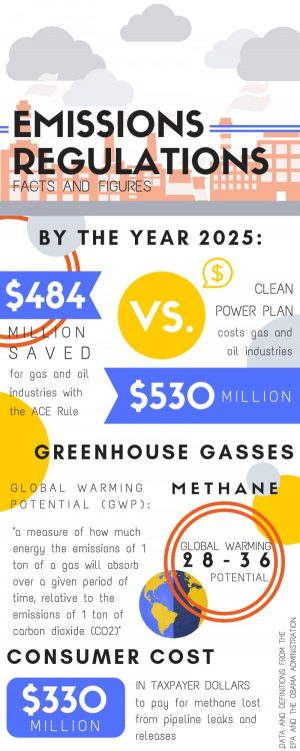Trump administration unravels Obama-era policy with rollback of emission regulations
October 17, 2018
Last month, the Environmental Protection Agency (EPA) announced their final plans to reduce methane emission regulations, echoing previous moves by the Trump Administration to weaken climate legislation that controlled the production of emissions.
Climate scientists warn that fewer regulations on methane production will lead to a higher atmospheric concentration of the most potent greenhouse gas. The New York Times reports that the new proposal will allow states to set their own methane standards while loosening rules that required companies to perform regular checks and reparations for methane pipelines. This change in policy was preceded by the EPA’s reveal of the Affordable Clean Energy (ACE) Rule in August, a replacement for the Obama-era’s Clean Power Plan (National Geographic).
While these recent steps taken by the administration to weaken pre-existing regulatory legislation on emissions have gone largely unnoticed — especially with the growing controversy surrounding Supreme Court Justice Brett Kavanaugh — changes to environmental policy have been proceeding somewhat inconspicuously for a while under the Trump administration. This May, the administration terminated NASA’s Carbon Monitoring System that was intended to keep tabs on global emissions levels (National Geographic). Just a month later, the New York Times reported that President Trump had pulled the U.S. from the Paris Climate Agreement.
 Taylor Atienza
Taylor Atienza
It’s evident that the Trump administration’s views on policy are almost directly opposite to that of the Obama administration. Many have applauded the EPA’s moves to counter legislation put in place by the previous administration.
“It all depends on who you trust,” said Kathleen Sgamma, president of the Western Energy Alliance, to the New York Times. “That administration trusted environmentalists. This one trusts industry.”
The shift in trust she describes is evident in the benefits for oil and gas companies; by 2025, the EPA estimated that Obama-era policies would cost fossil fuel industries approximately $530 million, while the policy revisions could save the oil and gas industry $484 million.
However, the methane regulation rollbacks have their economic downsides. While there was a predicted financial toll on industry, the Obama Administration also reported that methane lost as a result of pipeline leaks and releases amounted to a substantial $330 million for taxpayers to pay instead (PBS). Environmental groups objected to the reduction in protective climate legislation and affirmed the financial benefit of reducing methane emissions.
While methane isn’t often the contributor that is cited first in conversations about climate change and global warming, it still acts as an agent of these processes.
“Methane in particular is an especially potent greenhouse gas — although we often point our focus to carbon dioxide since it’s such a prevalent emission, methane is several magnitudes more capable of absorbing heat than carbon dioxide, making it more potent in its contribution to the global warming trend,” said science teacher Ms. Nguyen.
Emily Nash — senior and president of the Green Hearts club at Dougherty — explained the impact that warming caused by methane can have on the environment, especially in marine ecosystems.
“It’s also destroying our natural ozone layer, exposing us more to dangerous UV radiation from the sun. Along with this, as the earth continues to heat up, many organisms have to live in specific temperatures,” Nash said. “This is part of the reason why many species are going extinct, and the extreme coral bleaching in the oceans. The ocean is losing one of it’s most diverse ecosystems because of higher water temperatures and the sensitivity of the algae that live inside the coral. Many organisms use coral reefs as their homes, and they’ve already been massively destroyed. This will just progress their destruction.”
Similar to the new methane proposals, the statistics on the ACE Rule are reflective of the trend towards the prioritization of economics over environmental issues.
“EPA estimates that the ACE Rule could reduce 2030 CO2 emissions by up to 1.5% from projected levels without the CPP – the equivalent of taking 5.3 million cars off the road,” a news release from the agency reads. “Further, these illustrative scenarios suggest that when states have fully implemented the proposal, U.S. power sector CO2 emissions could be 33% to 34% below 2005 levels, higher than the projected CO2 emissions reductions from the CPP.”
The ACE Rule is also accompanied by some troubling predictions: The EPA has estimated that replacing the Clean Power Plan with the ACE Rule could result in particulate matter from emissions, potentially causing 1,400 premature deaths by 2030. Keeping the Clean Power Plan could have potentially prevented 1,500 to 3,600 premature deaths each year.
While reports from the EPA and U.S. Government suggest the new policies are financially auspicious, these benefits may also come at the expense of a slowed reduction of greenhouse gas emissions and human health.
“If it doesn’t directly affect where you live or the money you make or spend, it certainly at least has an impact on your health—the air, the water, and the soil quality are all negatively impacted by an increased concentration of emissions,” Nguyen said. “Everything is connected one way or another.”
With the continuing trend of the dismantling of climate legislation comes resistance from environmental groups and individual states alike. Although future changes in policy can’t be predicted as of now, the recent legislation passed under the Trump administration reveals a preference for policy that favors the nation’s economic interests over environmental welfare.

